|
1
|
Lei C, Niu X, Wei J, Zhu J and Zhu Y:
Interaction of glutathione peroxidase-1 and selenium in endemic
dilated cardiomyopathy. Clin Chim Acta. 399:102–108. 2009.
View Article : Google Scholar : PubMed/NCBI
|
|
2
|
Hwang JJ, Allen PD, Tseng GC, Lam CW,
Fananapazir L, Dzau VJ and Liew CC: Microarray gene expression
profiles in dilated and hypertrophic cardiomyopathic end-stage
heart failure. Physiol Genomics. 10:31–44. 2002. View Article : Google Scholar : PubMed/NCBI
|
|
3
|
Xiaohui S, He S and Hong TW: Comparative
analysis of gene expression profile between Keshan disease and
dilated. Experimental and Clinical Cardiology. 20:1373–1384.
2014.
|
|
4
|
Proctor KG, Falck JR and Capdevila J:
Intestinal vasodilation by epoxyeicosatrienoic acids: Arachidonic
acid metabolites produced by a cytochrome P450 monooxygenase. Circ
Res. 60:50–59. 1987. View Article : Google Scholar : PubMed/NCBI
|
|
5
|
Chaudhary KR, Batchu SN and Seubert JM:
Cytochrome P450 enzymes and the heart. IUBMB Life. 61:954–960.
2009. View
Article : Google Scholar : PubMed/NCBI
|
|
6
|
Fer M, Dréano Y, Lucas D, Corcos L, Salaün
J, Berthou F and Amet Y: Metabolism of eicosapentaenoic and
docosahexaenoic acids by recombinant human cytochromes P450. Arch
Biochem Biophys. 471:116–125. 2008. View Article : Google Scholar : PubMed/NCBI
|
|
7
|
Sidorik L, Kyyamova R, Bobyk V, Kapustian
L, Rozhko O, Vigontina O, Ryabenko D, Danko I, Maksymchuk O,
Kovalenko VN, et al: Molecular chaperone, HSP60 and cytochrome P450
2E1 co-expression in dilated cardiomyopathy. Cell Biol Int.
29:51–55. 2005. View Article : Google Scholar : PubMed/NCBI
|
|
8
|
Fuyu Y: Keshan disease and mitochondrial
cardiomyopathy. Sci China C Life Sci. 49:513–518. 2006. View Article : Google Scholar : PubMed/NCBI
|
|
9
|
He SL, Tan WH, Zhang ZT, Zhang F, Qu CJ,
Lei YX, Zhu YH, Yu HJ, Xiang YZ and Guo X: Mitochondrial-related
gene expression profiles suggest an important role of PGC-1alpha in
the compensatory mechanism of endemic dilated cardiomyopathy. Exp
Cell Res. 319:2604–2616. 2013. View Article : Google Scholar : PubMed/NCBI
|
|
10
|
Elbekai RH and El-Kadi AO: Cytochrome P450
enzymes: Central players in cardiovascular health and disease.
Pharmacol Ther. 112:564–587. 2006. View Article : Google Scholar : PubMed/NCBI
|
|
11
|
Maisch B: Classification of
cardiomyopathies according to the WHO/ISFC Task Force - more
questions than answers. Med Klin (Munich). 93:199–209. 1998.(In
German). View Article : Google Scholar : PubMed/NCBI
|
|
12
|
Livak KJ and Schmittgen TD: Analysis of
relative gene expression data using real-time quantitative PCR and
the 2(−Delta Delta C(T)) method. Methods. 25:402–408. 2001.
View Article : Google Scholar : PubMed/NCBI
|
|
13
|
Gottlieb RA: Cytochrome P450: Major player
in reperfusion injury. Arch Biochem Biophys. 420:262–267. 2003.
View Article : Google Scholar : PubMed/NCBI
|
|
14
|
Raucy JL, Mueller L, Duan K, Allen SW,
Storm S and Lasker JM: Expression and induction of CYP2C P450
enzymes in primary cultures of human hepatocytes. J Pharmacol Exp
Ther. 302:475–482. 2002. View Article : Google Scholar : PubMed/NCBI
|
|
15
|
Thum T and Borlak J: Gene expression in
distinct regions of the heart. Lancet. 355:979–983. 2000.
View Article : Google Scholar : PubMed/NCBI
|
|
16
|
Melin AM, Carbonneau MA, Thomas MJ, et al:
Dietary vitamins A and E affect differently lipid peroxidation in
rat heart and testis. J Clin Biochem Nutr. 18:19–33. 1995.
View Article : Google Scholar
|
|
17
|
Westphal C, Konkel A and Schunck WH:
CYP-eicosanoids - a new link between omega-3 fatty acids and
cardiac disease? Prostaglandins Other Lipid Mediat. 96:99–108.
2011. View Article : Google Scholar : PubMed/NCBI
|
|
18
|
Zeldin DC: Epoxygenase pathways of
arachidonic acid metabolism. J Biol Chem. 276:36059–36062. 2001.
View Article : Google Scholar : PubMed/NCBI
|
|
19
|
Seubert JM, Zeldin DC, Nithipatikom K and
Gross GJ: Role of epoxyeicosatrienoic acids in protecting the
myocardium following ischemia/reperfusion injury. Prostaglandins
Other Lipid Mediat. 82:50–59. 2007. View Article : Google Scholar : PubMed/NCBI
|
|
20
|
Xu X, Zhang XA and Wang DW: The roles of
CYP450 epoxygenases and metabolites, epoxyeicosatrienoic acids, in
cardiovascular and malignant diseases. Adv Drug Deliv Rev.
63:597–609. 2011. View Article : Google Scholar : PubMed/NCBI
|
|
21
|
Gross ER, Nithipatikom K, Hsu AK, Peart
JN, Falck JR, Campbell WB and Gross GJ: Cytochrome P450
omega-hydroxylase inhibition reduces infarct size during
reperfusion via the sarcolemmal KATP channel. J Mol Cell Cardiol.
37:1245–1249. 2004.PubMed/NCBI
|
|
22
|
Zordoky BN and El-Kadi AO:
2,3,7,8-Tetrachlorodibenzo- p-dioxin and beta-naphthoflavone induce
cellular hypertrophy in H9c2 cells by an aryl hydrocarbon
receptor-dependant mechanism. Toxicol In Vitro. 24:863–871. 2010.
View Article : Google Scholar : PubMed/NCBI
|
|
23
|
Zordoky BN, Aboutabl ME and El-Kadi AO:
Modulation of cytochrome P450 gene expression and arachidonic acid
metabolism during isoproterenol-induced cardiac hypertrophy in
rats. Drug Metab Dispos. 36:2277–2286. 2008. View Article : Google Scholar : PubMed/NCBI
|

















